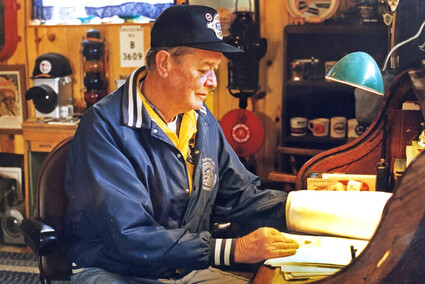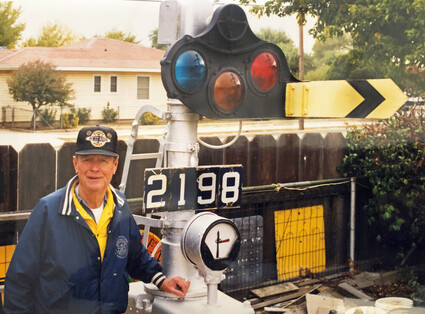Bill Stokoe: an unforgettable railroad man who made his own way in the world
Land of Four Seasons
April 1, 2023

Provided.
Bill Stokoe inside the little railroad museum he built in the backyard of his Tehachapi home. His collection of historic railway items constitutes the bulk of the artifacts in the Tehachapi Depot Museum.
If you visit the Tehachapi Depot Museum, you will encounter references to "the Stokoe Collection" and to Bill Stokoe, the man who gathered much of the assorted railroad memorabilia that is on display there. The late Bill Stokoe was, in a sense, the father of the depot museum. He was also a cherished friend of mine, and I'd like to tell you more about him and his remarkable life.
Bill was a longtime signal maintainer for Southern Pacific Railroad and a lifelong railroad man. He installed 15 working railroad signals in the backyard of his home on F Street, and some of them stuck up over the fence and were visible from the alley behind Red House BBQ. These assorted signals now comprise nearly all of the signal garden outside the depot museum.
Bill also built a small museum in his backyard to house his extensive collection of railroad artifacts, and I spent many happy hours with him in that railcar of a time machine, surrounded by historical objects and listening as he shared his encyclopedic knowledge of the railroad world.
Bill and his wife, Betty, and my Ma, Wini Hammond Hurst, and her brother, Henry Hand were fond of each other so I knew who Bill Stokoe was as I was growing up. When I began taking photos and writing stories about the Tehachapi area in 1981, Bill became a valuable resource about railroads. If I had any rail-related question, my first move was to call Bill or drop by his house, since his facts were always accurate and he was unsurpassed as a wellspring of knowledge.
Bill had an incredible memory and an innate ability to recall specific details, which made him a great source for someone like me when I wrote about railroad history. Bill was a tall, lanky man who had spent his productive life as a hard worker and keen observer, and his honesty and respect for facts meant that his stories and recollections were true, untainted by exaggeration.
Life didn't greet Bill with a smile and a blank check when he was born. He was fated to experience great loneliness and hardship in his later youth.
Bill's father had been in the British army as a teenager during World War I. The elder Stokoe was captured by the Germans and interred in a POW camp in the German countryside. He longed to escape, and one misty night, his opportunity came. Under cover of fog, he managed to crawl under the dense barbed wire fence that surrounded the hastily-built camp.
When he heard no gunfire or shouts, he knew he had eluded detection. In his pocket was a small amount of loose tobacco he had scrounged for weeks from discarded cigarette stubs, and a single rolling paper he had managed to salvage. He took his "fixings" and rolled a cigarette, but had no source of flame. In the foggy distance of that dark night, he saw a kerosene signal lantern at a railroad crossing.
Bill's father made his way to that remote lantern, climbed up the pole and lit his one carefully hoarded cigarette, feeling free for the first time in months.
The young Tommy soldier was later recaptured, but he survived the war. Bill told me he sometimes thought of his father climbing that railroad signal, and how it had seemed to his dad like a beacon of hope.
After the war, Bill's father moved to the U.S. and married an American woman, and worked in construction for Hollywood movie studios, building sets and other structures. When Bill was only 12 years old, he was orphaned when his father died of pneumonia and his mother followed just three months later from a weakened heart.
The young Southern California boy was sent to St. David, Arizona to live with an aunt and uncle. Although his basic needs were met, Bill's life was very spartan and he had few indulgences or warmth and love. He was given no spending money, and even though he was still a child, if he wanted something, he had to somehow earn it himself. Bill's uncle worked for the Apache Powder Company, manufacturing explosives, and when Bill was still a teenager he too went to work for Apache Powder.
In 1949, when he was 19, Bill was shooting pool in Benson when the owner of the pool hall told him that Southern Pacific was hiring track workers at the nearby town of Sibyl. Lacking a car, Bill had a friend drive him out to the work site, where he asked to foreman for a job. He was told to bring three friends and show up to begin work on Monday.
Bill did, and the four young men began replacing old rail with new sections. Each 39-foot long section weighed 1,716 pounds and would be moved by a crew of about 16 men using rail tongs. Most of the other workers were from Mexico, so the commands to raise, lower and other coordinated movements of the sections were in Spanish.
Even 50 years later, Bill could recall all the Spanish commands, even though he didn't know how to speak the language – that's how well he remembered details.
For their hard work, Bill and his friends received $1.16 per hour. After six months, the rail in that stretch of track had all been replaced and the job ended. One position was still available, and Bill suggested that he and his friends flip a coin to decide who would continue with the railroad.
His friends insisted that he take it, however, since he was the only one having to support himself – he was the orphan living on his own with no help from his family. Incidentally, Bill remained friends with the other three young men as long as he lived. That was another of his good qualities – loyalty to his friends. He valued friendship and was perpetually helping out the people he cared about.
Bill eventually transferred to the signal department and worked his way up to supervisor, but his experience on a track gang gave him appreciation for the skills required, and invaluable insight into that aspect of railroading.
Bill never regretted his pool hall decision to take a job with the railroad. He didn't like working at Apache Powder, and his choice of another line of work may have been lifesaving: a 1950 explosion at the nitroglycerin scale blew his uncle and another man into oblivion.
Bill retired from the S.P. signal department in 1989 after 40 years of service, but he remained fascinated by trains and railroads the remainder of his life. He collected memorabilia and did signal and railway research until the end of his life in October, 1999.
Despite the hardship he experienced in his life, Bill didn't let it make him cold or indifferent. He was still a loving person who adored his family and friends, which included his dogs and horses.
Bill Stokoe has played a big role in helping Tehachapi people appreciate their railroad heritage, and the high quality of the Tehachapi Depot Museum is partly a testament to his collection and his wealth of knowledge.

Provided.
Bill Stokoe in his backyard with some of the railroad signals that he refurbished into working order. They are now on display at Depot Park.
Nearly 25 years after his passing, I know that I still dearly miss Bill Stokoe and his generosity of spirit, and I will forever be grateful for his many kindnesses to me. I think of that orphaned boy, and I marvel at how well he played the meager cards that life dealt him. Thank you, Bill, your longtime home of Tehachapi still remembers you with affection and gratitude. . .
Jon Hammond is a fourth generation Kern County resident who has photographed and written about the Tehachapi Mountains for 38 years. He lives on a farm his family started in 1921, and is a speaker of Nuwä, the Tehachapi Indian language. He can be reached at tehachapimtnlover@gmail.com.




